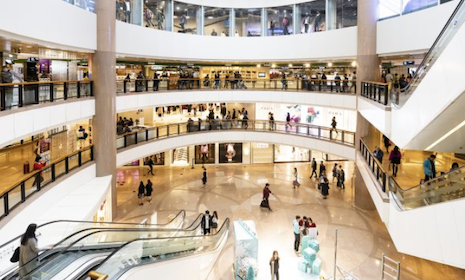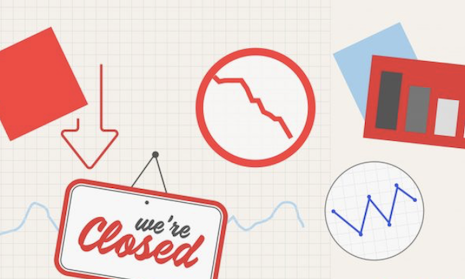 Daily walk-ins to physical businesses against COVID-19 cases in the area. Image courtesy of Zenreach
Daily walk-ins to physical businesses against COVID-19 cases in the area. Image courtesy of Zenreach
When COVID-19 first became part of everyday conversations in the United States, it was all about lockdowns and consumers avoiding stores and restaurants. But as time goes on, foot traffic into these physical spaces is becoming more nuanced, depending on the U.S. state.
Nationwide, there was a substantial decrease in foot traffic beginning in mid-March, with foot traffic hitting a low point in the U.S. in mid-April. Walk-ins were a mere 25.2 percent of last year’s numbers, per new data shared by Zenreach, although things are beginning to bounce back a bit.
“Recently, those foot traffic numbers have grown, but we are still only at approximately 50 percent of where we were at this time a year ago,” John Kelly, CEO of Zenreach, San Francisco.
“These numbers vary widely by state, with 'Optimistic States' seeing traffic levels bounce back above 50 percent in June and stay that way through July, while 'Cautious States' saw traffic levels that stayed below 50 percent," he said.
“In August, by contrast, we’re seeing a near-full reversal: the 'Cautious States' have rising numbers of foot traffic and falling numbers of new COVID-19 cases, while the 'Optimistic States' are now seeing drops in foot traffic along with spikes in infections.”
 Optimistic States were seeing traffic levels above 50 percent and Cautious States saw traffic levels that stayed below 50 percent, but this has changed in August. Image courtesy of Zenreach
Optimistic States were seeing traffic levels above 50 percent and Cautious States saw traffic levels that stayed below 50 percent, but this has changed in August. Image courtesy of Zenreach
No crystal ball
Research is finding correlations between restaurant spending and confirmed coronavirus cases in states across the country, which is a good indicator of what things might look like during a second wave and into next year.
JPMorgan recently observed a link between restaurant spending and confirmed coronavirus cases in states across the country. And data experts from Zenreach, who use Wi-Fi hotspots to track in-store foot traffic, are seeing the same trend in bar and nightclub traffic, perhaps hinting at what this will mean for physical businesses in the coming months.
But this can be tricky to predict.
Back in June, Zenreach, a company that specializes in driving foot traffic to physical locations, predicted that retail foot traffic would return to almost normal levels by August. However, in August the traffic is way lesser than anticipated.
“When we put out our first forecast back in June, we based it solely on the trends we were seeing in our foot traffic data, which at the time had shown two solid months of steady increase,” Mr. Kelly said. “As a result, we were able to extrapolate the trend line and determine a return-to-normal-traffic date. There was no crystal ball, just simple trendline extrapolations.
“We knew at the time, and indeed openly acknowledged, that other external factors—spikes in COVID-19 cases and further business shutdowns, most notably—could, and likely would, push these return-to-normal dates much further out than we initially predicted,” he said.
“Sure enough, those events have taken place, and retail traffic nationwide has started to dip again. As a result, we do not see a return to normal date this year.”
This is tough for retailers that have been hit hard this year to know what comes next when the future is so uncertain.
“We have seen some evidence that luxury retailers and fine-dining restaurants have been hit harder than other retailers during this crisis,” Mr. Kelly said.
“Unlike previous crises, however, the stock market has rebounded significantly as of late, which may foretell a better-than-typical recovery for the luxury sector,” he said.
 Marketing now is key to boosting store traffic when the pandemic ends. Image courtesy of Zenreach
Marketing now is key to boosting store traffic when the pandemic ends. Image courtesy of Zenreach
Digital will not replace physical
By contrast, online engagement and ecommerce are hitting all-time highs. As a result, many luxury retailers are shifting their marketing focus from driving customers into stores to driving them onto their Web sites for online purchases.
Brands that have been able to shift all or a majority of their offerings to ecommerce platforms are likely faring better during the pandemic than those that rely exclusively on in-store foot traffic.
“Studies have consistently shown, however, that consumers prefer to make most of their major purchases inside of a physical store,” Mr. Kelly said. “
The tactile experience will still be important," he said. "While the pandemic has accelerated the shifts to online, it most certainly will not destroy the entire offline retail experience. I think as the pandemic wanes over time, we’ll see a gradual return of foot traffic.”
Regardless of the outcome, do not expect to see in-store traffic levels to return to pre-COVID-19 levels for quite some time. The right marketing will be key to helping this foot traffic return when it is safe to do.
“It’s important for luxury brands to know who their best customers and prospects are,” Mr. Kelly said. “The ability to identify and market to those customers who come in frequently or are making bigger purchases is even more important in today’s environment.
“Once you know who your most valuable customers are, it’s imperative that you communicate with them during this time frame,” he said. “Just because you have a 'We’re Open' sign out front does not mean that your customers know that you’re open, especially when most of us are spending more time at home. Make sure to update your messaging to reflect the state of your business and get the word out.
“As counterintuitive as it may sound, now is the best time to advertise. With many competitors cutting back on ad spending, the cost of media has become quite inexpensive.
"Furthermore, online interactions and engagements are at record levels. Consumers are also more likely to perceive brands who advertise during downturns as leaders who are more stable and reliable, which could mean a big boost for your business, both now and after the pandemic passes.”
